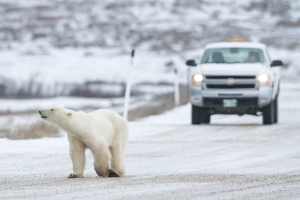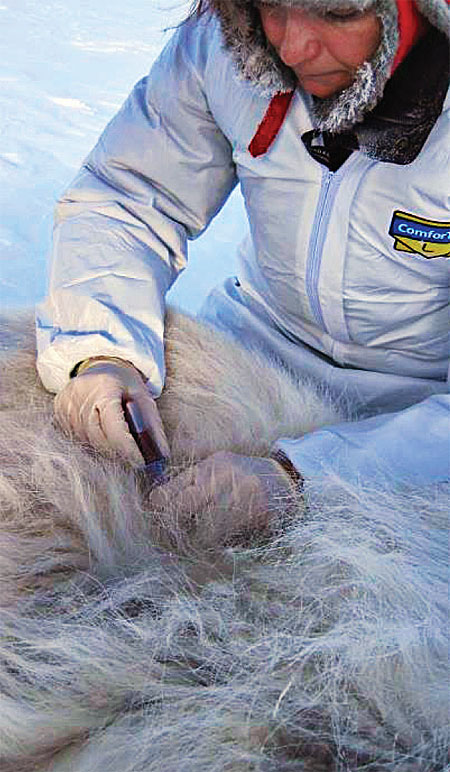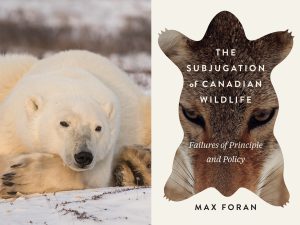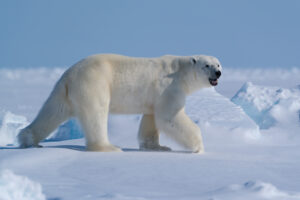
Wildlife
Think like a bear: learning to coexist
Humans and bears are sharing more landscapes now than ever before. As we continue to invade their world, will we be able to coexist?
- 4432 words
- 18 minutes
This article is over 5 years old and may contain outdated information.
People & Culture
Depending on whom you ask, the North’s sentinel species is either on the edge of extinction or an environmental success story. An in-depth look at the complicated, contradictory and controversial science behind the sound bites

On the western shore of Hudson Bay, it’s sometimes hard to remember that polar bears are supposed to be going extinct. Every fall, hundreds of bears gather near Churchill, Man., waiting for the bay to freeze so that they can head out onto the ice to hunt for seals. During this period, people in town treat polar bears more like nuisances than a sentinel species whose condition is regarded as the clearest evidence of the coming global climate apocalypse.
If a friend has ever shown you a snapshot of a polar bear, the odds are good that the photo was taken in Churchill. While Churchill is legendarily the Polar Bear Capital of the World, it is also the Polar Bear Tourism Capital of the World. There are 19 polar bear populations on the planet — 13 of them in Canada — and none is as accessible as in Churchill, which draws an estimated 10,000 visitors every year. If you’d like to scratch your itch for bear sighting in Baffin Bay or Tuktoyaktuk, N.W.T., you’ll probably need float planes, ski-touring gear and a solid knowledge of igloo architecture. But in Churchill, all it takes is a whole lot of disposable income. With hotels, ranger stations and perky multilingual guides, the town is entirely geared toward the modern ecotourist. For the modest sum of $11,349 (per person), you can have the “Ultimate Polar Bear Experience”: 10 days in the Tundra Buggy Lodge, essentially an oversized RV parked at the water’s edge.
By mid-November, the Churchill polar bears have not eaten a full meal in four months, and they spend their days conserving energy. They laze about in front of the assembled crowds, walking in circles, licking at the ground and just generally killing time. Tourists jostle one another, hoping for killer photo ops: the cutest cub, the biggest battle-scarred male, the particularly curious subadult that rears up on its hind legs and slaps its paws against the windows of the tour bus. Occasionally, a bear wanders right into town to take a swipe at a garbage can or sniff longingly at the odours wafting out of Gypsy’s Bakery.

The tourists come, of course, because polar bears are a dying breed, and they want to check that furry face off their life lists before it’s too late. The environmental movement has never had a higher-profile spokesmodel than Ursus maritimus. Every discussion about global warming has to include a mention of polar bears; every article about the human disregard for nature has to feature a photograph of a sad-looking bear on a tiny speck of ice.
Granted, the population numbers have been startling. Research from 1984 to 2004 showed that the western Hudson Bay population, which includes the Churchill bears, had declined from 1,194 to 935. The trend lines from that study suggested that by 2011, the population would fall to as low as 676.
Fast-forward to today and a new study, which reveals that the current polar bear population of western Hudson Bay is 1,013 animals.
Wait … what? More bears than there were 10 years ago? Nearly double the prediction? “Polar bears are one of the biggest conservation success stories in the world,” says Drikus Gissing, wildlife director for the Government of Nunavut. “There are more bears here now than there were in the recent past.”
“That’s false,” says Kassie Siegel of the Center for Biological Diversity, the international advocacy organization that, in 2008, successfully pushed to have polar bears listed as “threatened” in the United States. “Polar bear populations are in decline. That means individual bears are starving and drowning.”
Polar bears can weigh more than 500 kilograms, they drag seals out of the ocean with their claws, and on occasion they will attack human beings. In short, these animals are not known for their subtlety. And yet a deep dive into the current science behind polar bear population dynamics produces results that are complicated, contradictory and often quite controversial. For the segment of the media that traffics in sound bites, it’s easy to declare that polar bears are on the verge of extinction … or that this is just another example of the climate-change myth. The truth, as usual, lies somewhere in between.
Underlying any story about polar bear populations is the reality that it can be extremely difficult working with polar bears. They can range across international boundaries, over hundreds of kilometres of forbidding ice and frigid open water. They can dig into dens or camouflage themselves on snowfields. And mark-recapture studies, in which bears are tranquilized, are problematic. Drugging bears is dangerous for both the animals and the scientists, and Inuit often object to such invasive interactions, since drugging and physically handling bears stresses the animals and is an affront to traditional ecological practices.
So scientists end up counting bears in many different ways, including incorporating observations by knowledgeable local residents. But population estimates are just that: estimates. Some subpopulations of bears haven’t been counted in decades, if ever. And some are counted more frequently but with slightly different survey areas or methodologies from year to year. The Polar Bear Specialist Group, an international consortium of experts, classifies 10 of the 19 subpopulations as being “data-deficient,” which isn’t exactly conducive to a coherent discussion about how polar bears are faring worldwide.
Despite all this hedging, the numbers still tell a powerful story. It’s just not always clear what that story is. In Davis Strait, between Greenland and Baffin Island, the polar bear population has grown from 900 animals in the late 1970s to around 2,100 today. In Foxe Basin — a portion of northern Hudson Bay — a population that was estimated to be 2,300 in the early 2000s now stands at 2,570. And in specific areas of western Hudson Bay, the most-studied, most-photographed group of bears on Earth seems to have been on a slow but steady increase since in the 1970s.
News like this leaves climate-change deniers crowing from the rooftops. But a closer look reveals that everything may not be quite so sunny. “Some populations appear to be doing OK now, but what’s frightening is what might happen in the very near future,” says wildlife biologist Lily Peacock, who has worked with polar bears for the Government of Nunavut and the U.S. Geological Survey. “All indications are that the future does not look bright.” While population trends might appear stable, she says, “we’re picking up declines in body condition that are really frightening.” Scientists have shown a direct correlation between warm years and skinny bears. Even more distressing, one study predicted that 40 to 73 percent of pregnant females could fail to deliver healthy cubs if ice breakup happens one month earlier than in the 1990s. Polar bears are long-lived animals that reproduce slowly; counting the number of animals that are alive today might not paint an accurate picture.

Take the population in the greater Churchill area, for example, which was analyzed in a 2012 paper entitled Western Hudson Bay Polar Bear Aerial Survey. While the Government of Nunavut, which commissioned the study, was quick to trumpet an increase in polar bear numbers — and call for higher hunting quotas — the University of Minnesota scientists who actually did the work were more judicious. The sea ice in Hudson Bay is now breaking up two to three weeks earlier than it did three decades ago. And since a bear on land is easier to spot from a helicopter than a bear on the ice, catastrophically early ice breakup may have just made the bears more visible. By that logic, a higher count could actually be evidence that the bears are doing worse.
Even more troublesome is the fact that the number of cubs observed in the western Hudson Bay population is dramatically lower than in the past. While adult bears may be fat and savvy enough to survive a few lean years, juvenile bears reach a tipping point quickly. Despite the triumphal notes sounded by the Nunavut government, the study’s authors point out that the scarcity of cubs undercuts the entire hypothesis that “increasing numbers of bears … are the result of overall subpopulation growth.”
While it’s tempting to talk about polar bears as a single-species group, the truth is that the success or failure of a single subpopulation might say very little about the health of another one. “The thing to remember is the vast range of the polar bear and the utter size of the Arctic,” says Geoff York, the Ottawa-based senior program officer for the World Wildlife Fund’s Global Arctic Programme. “Impacts from warming are unfolding at different rates and different time scales.” Polar bears that make their home in James Bay — at the fifty-third parallel north — have experienced ice-free summers for thousands of years. Bears in the High Arctic Archipelago, however, contend with pack ice so thick that it’s often impossible for them to hunt seals. In the southern reaches of the bears’ range, warming could be catastrophic, but higher north, an increase in open water could potentially make hunting easier.
In Davis Strait, for example, both the extent and thickness of the sea ice have been declining dramatically. In theory, this should be trouble for the local bears, which, like polar bears everywhere else, rely on solid sea ice as a hunting platform. Yet this population is an eye-popping 233 percent bigger than it was four decades ago. It’s tempting to simply declare victory and walk away. And yet this new-found abundance is entirely the result of local management practices that originally had nothing to do with bears. Specifically, in 1983, the European Economic Community banned the importation of the hides of whitecoat harp seal pups. In most places, the polar bear diet consists primarily of ringed or bearded seals. But polar bears aren’t picky eaters; when harp seal populations exploded, polar bears gorged. On the other hand, one theory holds that the loss of sea ice could encourage killer whales to move into polar bear habitat, snatching up all the seals and becoming the new dominant marine mammal.
And what about other menu items besides seal meat? During springtime in Wapusk National Park (just outside of Churchill), tens of thousands of lesser snow geese can be found nesting at around the same time polar bears are coming ashore. As ice breakup occurs earlier, the overlap between the bears and birds gets closer in line. While a bear would have to eat the contents of about four dozen nests to equal the caloric equivalent of just one “seal day,” there is a possibility that an occasional egg smorgasbord could help offset the effects of sea ice loss.


As if global warming weren’t enough of a problem, polar bears face a host of other assaults, not the least of which is hunting. By definition, there is no “sustainable” harvest quota for a population already in decline. That seems obvious, right? And yet it also happens to be the wrong answer. When it comes to the science and politics behind hunting, we have to follow polar bears down the rabbit hole once again.
In Canada, hunting rules are determined by individual provinces and territories, so a particularly peripatetic bear in Hudson Bay could wind up being “managed” by Manitoba, Nunavut, Ontario, Quebec and possibly even Newfoundland. Factor in the disparate laws in the other four polar bear nations — the United States, Russia, Greenland and Norway — and you’ve got a recipe for worldwide confusion.
Approximately two-thirds of the world’s polar bears live in Canada, and about 600 are legally hunted here every year. Of that, 86 percent of the hunting occurs in Nunavut. For years, First Nations and Inuit residents of polar bear country have reported increased interaction with bears. More bears are coming into settlements, scavenging garbage, hassling dogs and terrifying residents. But some scientists counter that if bears were doing well, they wouldn’t come around town and, therefore, a greater number of bear encounters is actually evidence of fewer bears.
Inuit and Cree have harvested Hudson Bay’s polar bears for 6,000 years, before climate change was on anybody’s radar. Harvest levels in modern times have ebbed and flowed according to management and political priorities. Between 2004 and today, according to Nunavut’s wildlife director Drikus Gissing, allowable harvest levels in western Hudson Bay dropped from 56 to 38 and then to 16 — a number that was shared between Manitoba and Nunavut and also had to include unplanned “defence kills.” For locals, hunting is important not just for meat, hides and cultural continuity but also as a significant source of income, since some tags are sold to sport hunters for tens of thousands of dollars.
Terry Audla, the president of Inuit Tapiriit Kanatami, Canada’s national Inuit organization, says that when it comes to really understanding how healthy the polar bear population is, it makes no sense to pit the feelings and hunches of far-flung conservationists against the direct observations of local people who deal with the bears all the time. As far as overhunting goes, says Audla, “if you’re reliant on something as a source of food, you’re going to make darn sure that you’re keeping that source healthy.” When you live in Resolute Bay, Nunavut, it’s hard to give a lot of weight to a conservation organization in southern California or a worldwide endangered species treaty that is signed in Qatar. “There’s this whole fad down south about the 100-mile local diet,” says Audla, laughing. “Well, we’ve been doing that forever.”
But even local management of hunting is not without pitfalls. While the territorial government in Iqaluit enforces strict rationing laws, hunters in Quebec (where no annual quota is applied) recently killed 90 bears in a single season. As a result, empty-handed hunters in Nunavut felt that their traditional rights were being curtailed. And when you lose the active engagement of the local population, you’re likely to have more polar bears killed rather than fewer. “The Inuit have been respectful of the quota system,” says Gissing. With an annual harvest of around 450 bears in Nunavut, there are only a handful of poaching incidents every year, a far lower percentage than is seen with other biggame species worldwide. But with quotas going down at the same time that locals are seeing more bears than ever, that level of respect is at risk. Mitch Taylor, who spent 21 years as a polar bear biologist for the Government of Nunavut and now teaches at Lakehead University in Thunder Bay, Ont., believes “local hunters are often better informed than managers and sometimes better informed than researchers on polar-bear trends in their area, and when managers request reductions in quota because of concerns that are ill-founded, those hunters are within their rights to address the misconceptions and clarify what populations really are doing.”
And, to add even more complexity, for populations that are stable or rising, an overabundance of bears might lead to competition for food, decreasing the health of the entire population. In situations like this, limited hunting could improve overall health.
Even Geoff York of the World Wildlife Fund — not exactly an organization known for its wanton blood lust — floats the possibility of killing polar bears as a management tool. “This would be a difficult decision for such an iconic species, but it may become a reality as ice loss outstrips predictions in many regions of the Arctic,” he says. “You may have bears at risk of starving during increased open-water periods. The reality is polar bears showing up in places like Churchill, where you might have increased predation of cubs and more bears starving to death, with people watching and cameras clicking.” And pretty much everyone agrees that rich tourists enjoying their morning lattes on deluxe Arctic extravaganzas don’t want to watch polar bears dying.
Sometimes it feels as though the closer you look at polar bears, the harder they are to really see. Each new bit of evidence seems designed to give another spin on the wheel of public opinion. One recent study says that polar bears have been seen swimming as far as 687 kilometres through open water, which certainly sounds like an ominous sign. Then another study suggests that polar bears could be up to 500,000 years older than previously thought, which means they’ve successfully survived multiple warming periods in the past. So that’s a good thing, right? But then you read the study about mysterious hair loss or the one about how polar bear milk has become contaminated with PCBs and mercury, and you get disappointed all over again.
So bear populations are either increasing or declining. Hunting is either an ecological outrage or a perfectly sustainable aboriginal right. On balance, the majority of polar bear scientists agree that even if the current state of things looks shakily stable, the future for bears is poor. Nonetheless, as long as climate change is political, polar bears will be too. And the tone of the discussion can get downright ugly.
Consider Mitch Taylor’s story. He spent more than two decades as a polar bear researcher and manager for the Nunavut government and has published around 50 peer-reviewed papers. That should garner widespread respect. But Taylor has been highly vocal about his belief that polar bears are mostly doing fine, that cub mortality varies from year to year and that the much ballyhooed predictions of extinction by 2050 are “a joke.” He also alleges that a lot of the “exaggerated decline” is just a way to keep certain scientists well funded and to transfer control of the polar bear issue from territorial to federal hands. In response, Taylor’s critics disinvited him from meetings of polar bear specialists that he’d been attending since 1978. They also like to point out that he’s a signatory of the Manhattan Declaration, which questions the very existence of climate change. But amidst all the heated charges and countercharges, it’s hard to argue the fact that few people know polar bears the way Taylor does. And while it might be inconvenient for current political posturing, there’s no denying that certain subpopulations of polar bears are managing to survive, even thrive.
Unlike some endangered species that can be saved by roping off a grove of trees, polar bears live locally and suffer globally. Although some scientists have suggested creating protected refuges in the High Arctic, what’s really important is how much rain forest the Brazilians will burn in the next 50 years and how many Texans will buy SUVs instead of tuning up their 10-speeds. And few of the environmentalists who visit Churchill talk about the thousands of kilometres they flew to get there or whether a tourist town in the middle of nowhere is part of the reason why the sea ice is melting in the first place.
The current scientific consensus places the worldwide polar bear population between 20,000 and 25,000 animals. Prior to the 1973 worldwide restriction on commerical polar bear hunting, that number was dramatically lower, so low that a meeting of polar bear specialists in 1965 concluded that extinction was a real possibility. Some reports even estimated the number of bears as low as 5,000 worldwide. Yet by 1990, Ian Stirling — at the time, the senior research scientist for the Canadian Wildlife Service and a professor of zoology at the University of Alberta; basically, one of the most respected polar bear scientists on the planet — felt comfortable answering the question as to whether polar bears are an endangered species by stating flatly: “They are not.” He went on to say that “the world population of polar bears is certainly greater than 20,000 and could be as high as 40,000 … I am inclined toward the upper end of that range.” Although old studies are sketchy, clearly more polar bears are alive today than there were 50 years ago, an essentially heartening fact that has not managed to pierce the public consciousness.
The percentage of people on Earth — heck, even the percentage of people in Canada — who have ever seen a polar bear amounts to a rounding error down around zero. In that context, it’s hard to understand what extinction really means. The new inability to see an animal that you never had the opportunity to see before? Of course, the polar bear has intrinsic worth beyond its value to humans, but is it really more valuable than the thousand other threatened species whose names you’ve never heard and whose faces you’ve never seen on a magazine cover? The truth is, the polar bear exists in a space that is as much theoretical as it is tangible. Given current climatological trends, it seems likely that the future of the polar bear is bleak … although its current status is almost certainly stronger than the international conversation would have one believe.
But polar bears don’t think in terms of trends — or politics or marketing or even in time periods longer than the interval until their next seal kill. And while the debate rages and the tourists’ cameras fire away, the polar bears themselves will continue to do what they’ve always done: surviving as best they can in whatever conditions the Arctic throws at them.
From its double-layered coat to the furry underside of its paws, the polar bear is well adapted to frigid Arctic temperatures. A male Ursus maritimus, the largest member of the bear family, can stand more than three metres tall on its hind legs, weigh 600 kilograms and live up to 30 years. A female gives birth every three years or so, usually to twins that stay with their mother for more than two years. The polar bear’s diet consists primarily of the skin and blubber of ringed and bearded seals. It hunts seals using its keen sense of smell and incredible patience, tracking down birth lairs or waiting hours for a seal to surface at a breathing hole.
There are 19 subpopulations of polar bears in the world, of which 13 can be found in Canada. The southern Beaufort Sea population, shared with Alaska, and the northern Beaufort Sea population, both of which are off the coasts of the Yukon and Northwest Territories, are either in or predicted to decline. A small population in Viscount Melville Sound, off the northern coasts of Victoria and Banks islands, could increase with changing sea ice conditions. M’Clintock Channel, off eastern Victoria Island, has seen polar bear numbers drop from about 900 to less than 300 over the past three decades. Lancaster Sound, off Baffin Island’s northern coast, is home to a declining population. The Gulf of Boothia population, off the northwestern end of Baffin Island, is stable. Foxe Basin is home to one of Canada’s largest polar bear populations, estimated at more than 2,500 animals in 2010. Norwegian Bay polar bears, south of Axel Heiberg Island and west of Ellesmere Island, are genetically different from all other polar bears worldwide, and their population status is unknown. Although the health of the western Hudson Bay population is the subject of debate, southern Hudson Bay, home to the most southerly polar bear population in the world, is relatively stable. Canada shares three of its populations with Greenland: the Baffin Bay and Kane Basin groups are both decreasing in numbers, while the Davis Strait population has increased in the past few decades but may now be in decline. The status of Greenland’s other two populations, in east Greenland and the Arctic Basin, is unknown. Russia is home to four populations of polar bears. The Barents Sea population, shared with Norway and Greenland, is healthy, while the status of the Kara Sea and Laptev Sea populations is unknown. The Chukchi Sea polar bears, shared with Alaska, could be in decline, though their current status is unclear.
Scientists study and count polar bears using two methods: capture-recapture and aerial survey. Capture-recapture, though dangerous because of the researchers’ proximity to the bear, helps determine the health and range of a population. Scientists take skin and blood samples, measure the bear’s height and weight and use ear tags to identify the country of capture. In an aerial survey, researchers in helicopters count bears along a predetermined line. This method can be tricky, as polar bears blend in well with the ice and bears in dens or behind ridges can be missed.
Warming temperatures are affecting the range of polar bear populations, shrinking their habitat and eventually, scientists fear, their numbers. While some northern bears may benefit from a more readily available diet, southern bears could find that food sources such as seal are more difficult to hunt and that human-bear encounters occur more frequently. Melting sea ice forces polar bears to fast for longer periods of time, impacting reproduction rates and the overall health of a population. Warming temperatures also increase human traffic, bringing pollution that impacts the health of both the bears and their prey.
Are you passionate about Canadian geography?
You can support Canadian Geographic in 3 ways:

Wildlife
Humans and bears are sharing more landscapes now than ever before. As we continue to invade their world, will we be able to coexist?

Wildlife
An excerpt from Gloria Dickie’s book, Eight Bears: Mythic Past and Imperiled Future, which explores the planet’s eight remaining species of bears and the dangers they face

Wildlife
In a new book, Max Foran denounces Canada's failures in protecting its wildlife from human exploitation

Wildlife
Honouring one of Canada’s most beloved bears with stories about how polar bears hunt, how they are adapting to life on land, how they may have evolved and more!